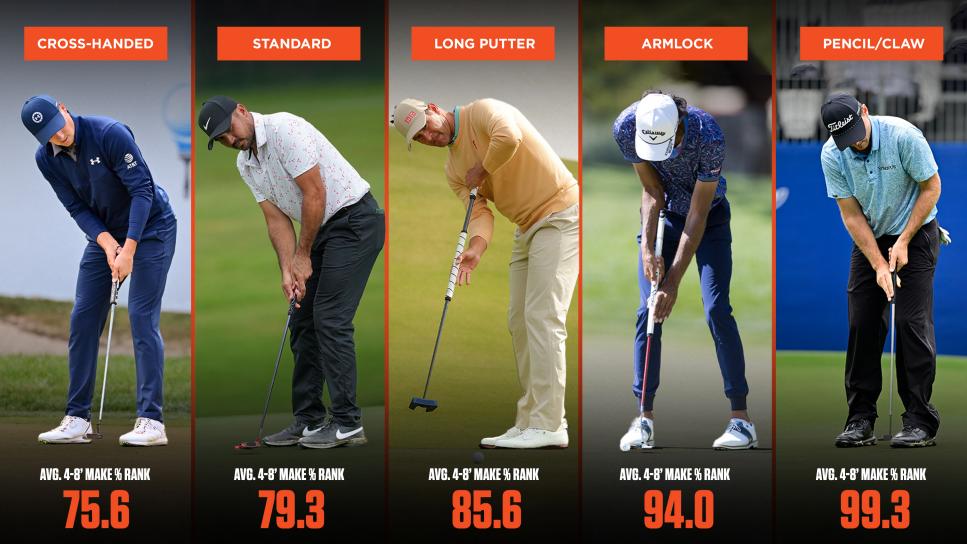If there has been a theme in PGA Tour putting over the last decade, it’s players’ willingness to try new methods. The stigma that unorthodox grips are a cover for players battling the y-word has diminished. This trend intensified after the anchoring ban took effect in 2016, and this year on tour, over a third of players used an alternative grip—be it cross-handed, pencil, claw, long putter or armlock.
Which of these methods is most successful? Are some of these grips better suited for a certain skill like short putting or avoiding three-putts, or does one perform better across the board? We analyzed the performance of the top 125 players on the 2022-’23 FedEx Cup list through the Tour Championship, comparing players across the five most common methods. To judge players’ skill at different aspects of putting, we looked at their rankings in three statistics: strokes gained/putting, 4-8′ make percentage and three-putt avoidance.
Before we get into the stats, it’s important to note that since the sample size for most of these methods is fairly small, we should be careful not to make too many blanket judgements based on the data.
For example, just two players—Matt Kuchar and Akshay Bhatia—used the armlock method for most or all of the season (Kuchar uses a reverse armlock grip). Five players used a long putter and 13 used a pencil or claw grip. Not surprisingly, the most common alternative grip is cross-handed, with 24 players using it this year. The largest sample size is the standard grip, with 81 players inside the top 125 using it.
Strokes gained/putting 
The 24 players who used a cross-handed grip this season averaged the best strokes gained/putting rank compared to all other methods. Their average rank was 69, compared to the standard contingent, who came in second at 75.2. Surprisingly, however, there is a steep fall off after those two methods as you can see in the graphic above.
In some ways, this makes sense. Cross-handed is increasingly seen as a conventional way to putt given that it helps properly align the shoulders. It is seen less as a quick fix for a faulty stroke like some of the other methods. Therefore, it’s expected that those players turning to more unique methods, like the claw or a long putter, tend to struggle more on the greens in general versus the players who use a more conventional grip like standard or cross-handed.
Short putting 
Cross-handed players also rank best on average in make percentage from four to eight feet. This makes sense considering that players often switch to this method for increased stability from short range. Left-hand-low helps to take the right hand out of the stroke, eliminating the over-active right hand that can cause short misses with a standard grip.
Players also turn to the armlock method for better stability on short putts, which is why on the surface it’s surprising that they rank lower here. Yet, this data is very limited considering just Bhatia and Kuchar used the method for most of this year. Kuchar ranked 12th in the stat (through the Tour Championship) and Bhatia struggled, ranking 176, making it very difficult to draw any conclusions.
Though cross-handed is one option to fix a shaky right hand, perhaps the most popular fix is to use a claw or pencil grip which takes much of the right hand off the grip of the club. Those players, however, average the worst rank in putting from four to eight feet, with only one player—Taylor Pendrith—in the top 20. This suggests that though this style of grip may help some with short putts, it’s not a catch-all fix.
Three-putt avoidance 
It is somewhat surprising to see that the five players who use a long putter average the highest rank in three-putt avoidance given that the technique can be tough to control distance with. A theory is that some of those who use a long putter, like Adam Scott and Lucas Glover, are among the best ball-strikers on tour, so they are leaving themselves closer to hole on their approaches, making three-putts less likely.
The cross-handed contingent doesn’t fare as strong in three-putt avoidance, ranking fourth out of the five techniques. While cross-handed may be the best technique from short range, players who use it are not as effective from longer range. Just one player—Sam Ryder—was inside the top 10 in the stat among the 24 players we counted. This could be because the right hand—considered by many (including Tiger Woods) to be most responsible for feel—is taken out of the stroke with a cross-handed grip.
You’ll notice that in all three stats we looked at, the standard grip had the second-highest average rank. Compared to the other techniques, the standard grip is consistently strong from short and longer range, which is not surprising: If those players were struggling, they’d likely consider an alternative method.
This article was originally published on golfdigest.com

